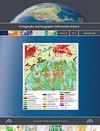张伯伦立体地图投影的变体
IF 2.4
3区 地球科学
Q1 GEOGRAPHY
Cartography and Geographic Information Science
Pub Date : 2021-09-29
DOI:10.1080/15230406.2021.1975571
引用次数: 0
摘要
摘要:我们提出了Chamberlin三分图投影的一种变体。这种新的投影,我们称之为矩阵三聚投影,由一个给定点和三个控制点之间距离的平方的线性变换组成。正投影的公式比Chamberlin投影更简单,并且允许只需要一个参数的数值迭代的逆公式。我们使用一个具有代表性的控制点列表对这两个预测进行比较。在角度变形和面积变形的测量上,Chamberlin三角投影优于矩阵三角投影,但在距离变形的测量中则相反,并且在所有测量中投影结果之间的差异很小。前向矩阵三聚投影可以在Chamberlin三聚投影的一半时间内计算。我们得出结论,矩阵三聚投影是Chamberlin三聚投影的可行替代方案,特别是在需要求逆或速度很重要的情况下。本文章由计算机程序翻译,如有差异,请以英文原文为准。
A variation on the Chamberlin trimetric map projection
ABSTRACT We present a variation on the Chamberlin trimetric map projection. This new projection, which we call the matrix trimetric projection, consists of a linear transformation of the squares of the distances between a given point and three control points. The formula of the forward projection is simpler than the Chamberlin projection, and admits an inverse formula which requires numerical iteration of only one parameter. We make comparisons between the two projections using a representative list of control points. The Chamberlin trimetric projection outperforms the matrix trimetric projection on measures of angle deformation and area deformation, but the opposite is true for a measure of distance deformation, and the difference between the results of the projections is small over all measures. The forward Matrix trimetric projection can be calculated in half the time of the Chamberlin trimetric projection. We conclude that the matrix trimetric projection is a viable alternative to the Chamberlin trimetric projection, especially if an inverse is required or speed is important.
求助全文
通过发布文献求助,成功后即可免费获取论文全文。
去求助
来源期刊
CiteScore
5.20
自引率
20.00%
发文量
23
期刊介绍:
Cartography and Geographic Information Science (CaGIS) is the official publication of the Cartography and Geographic Information Society (CaGIS), a member organization of the American Congress on Surveying and Mapping (ACSM). The Cartography and Geographic Information Society supports research, education, and practices that improve the understanding, creation, analysis, and use of maps and geographic information. The society serves as a forum for the exchange of original concepts, techniques, approaches, and experiences by those who design, implement, and use geospatial technologies through the publication of authoritative articles and international papers.

 求助内容:
求助内容: 应助结果提醒方式:
应助结果提醒方式:


